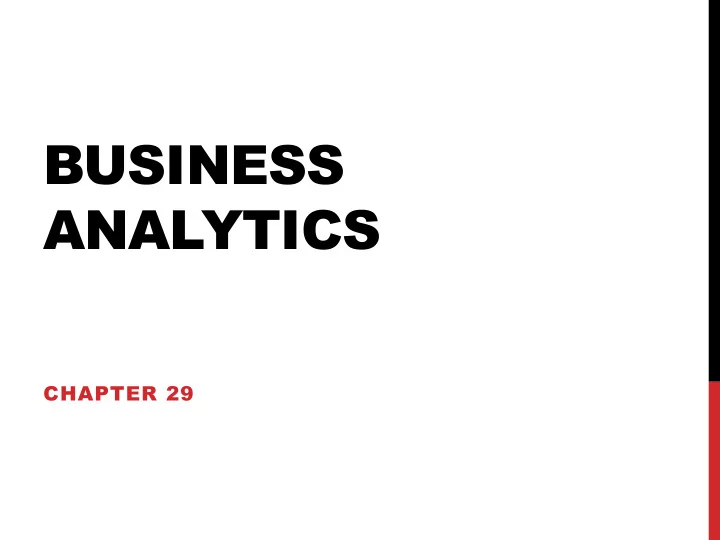

BUSINESS ANALYTICS CHAPTER 29
LECTURE OUTLINE Data warehouses Comparison with operational databases Multi-dimensional schemas Functionality of a data warehouse 2
DATA WAREHOUSES Data warehouse • “A subject -oriented, integrated, nonvolatile, time-variant collection of data in support of management’s decisions.” [ W.H.Inmon] • Data comes from multiple databases • Tools to make business decisions quickly and reliably based on historical data Supported applications • OLAP (Online Analytical Processing) • Analysis of complex data from data warehouse • DSS (Decision Support Systems) • Also known as EIS (Executive Information Systems) • Provides data and tools for complex decision-making • Data mining • Knowledge discovery: searching data for unanticipated new knowledge 3
INTEGRATED WAREHOUSE AND DB Extract, Transform, and Load (ETL) • Extracted from multiple, heterogeneous sources. • Includes data cleaning to ensure validity and consistency • Back flushing : upgrading the data with cleaned data Analyzed data fed back into operating DB and data management Back Flushing Data Warehouse OLAP Data DSSI Cleaning Reformatting Databases EIS Metadata Data Mining Other Data Inputs Updates/New Data 4
DATA WAREHOUSES VS. DBS Operations • Data warehouses optimized to find data correlations and to support trend analyses • Traditional databases are transactional: optimized for access, update, and integrity assurance • Data warehouses are less volatile than operational DBs. Data currency • Operational DBs required to maintain up-to-date, detailed data • Data warehouses characterized by historical data • Information in data warehouse is relatively coarse grained (“view from 10,000 ft.”) and refresh policy is carefully chosen, usually incremental. Data volume • Data warehouses may be exceptionally large (7 years of records) Data warehouse can be interpreted as a (special) view of the data. 5
MULTI-DIMENSIONAL SCHEMAS Multi-dimensional schemas specified using: • Dimension table • Consists of tuples of attributes of the dimension. • Fact table • Each tuple is a recorded fact. • Some measured or observed variable(s) and references to dimension tables. 6
WAREHOUSE FUNCTIONALITY Roll-up : Data is summarized with increasing generalization • E.g., going from daily or weekly reports to annual aggregations Drill-Down : Increasing levels of detail are revealed • E.g., going from national sales to sales from a particular region Pivot : Cross tabulation is performed from given perspective Slice and dice : Select and project data wrt some dimensions Plus traditional operations • Sorting by ordinal value. • Selection by value or range. Derived attributes: Attributes are computed by operations on stored derived values. 7
DATA MODELING FOR WAREHOUSES OLAP data cube Three dimensional data cube roll up r e 4 t r a r t u Q Q 3 l a r t c Q s i F 2 r t Q 1 r t Q Reg 1 Reg 2 Reg 3 P P123 r Two Dimensional Model P124 o REGION d P125 u REG1 REG2 REG3 c P126 t : P : R e g i o n P123 R O P124 D U C P125 T P126 : : drill down 8
LECTURE SUMMARY Glimpse at DBMS support for business analytics • Role of data warehouses OLAP cube • Model and operations 9
Recommend
More recommend